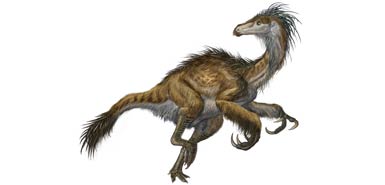This feather is believed by researchers to have been used by the animal to signal its intentions to potential mates and as a means of warning off rivals.
The discovery of the elongated broad filamentous feathers has excited palaeontologists, who believed that such coverings existed but had never seen them.
It is believed that dinosaurs had them at some point in the past because more advanced forms have already been discovered on dinosaur remains.
The primitive feathers on the Beipiaosaurus dinosaur are similar to the earliest forms seen on ancient birds. While the Beipiaosaurus feathers dated from about 20 million years after the time when Archaeopteryx, the earliest bird yet discovered, was alive the form is thought to have evolved first on dinosaurs. The discovery in China proves that they had them.
The second type of feather found on the fossilised dinosaur, which would have grown up to three metres (10ft) long, was a more advanced type and is thought to have been used for insulation. Feathers from the animal were clearly visible on the fossilised remains of half a skeleton, including the head, neck and part of the tail. Those that were used for communication grew most densely on the back of the neck and at the end of the creature’s tail.
Professor Xing Xu, of the Chinese Academy of Sciences in Beijing, said that Beipiaosaurus would have been unable to fly but that other types of dinosaur in the region, such as Microraptor, would have been able to take to the air.
He told The Times: “Feathers are diverse in morphology and function. In Beipiaosaurus most filamentous feathers that are slender and short are probably for insulation and the specialised elongate broad filamentous feathers are probably for display.
“This dinosaur is about 2-3 metres in total body length. It is probably a plant-eater – eating some soft plants. It probably lived by a lake near which is a big forest.”
The professor and colleagues from the Shandong Tianyu Museum of Nature and the Chinese Academy of Geological Sciences reported their findings in the journal Proceedings of the National Academy of Sciences.
In their report the scientists concluded that the discovery of primitive feathers “strongly supports the hypothesis that feathers evolved and initially diversified in nonavian theropods before the origin of birds and the evolution of flight”.
页面没有找到
